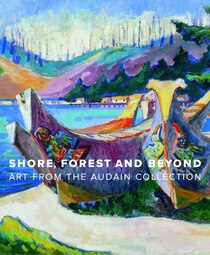Shore, Forest and Beyond: Art From the Audain Collection
Review By Maria Tippett
November 4, 2013
BC Studies no. 174 Summer 2012 | p. 138-9
At the beginning of the twentieth century British Columbia had a reputation for being a place where, as one journalist at Vancouver’s Province (16 October 1904) put it, there was little support for the province’s “gallant little band” of artists. Within a few decades, however, all of this would change. By the end of the First World War every town and city in British Columbia had an art society — some even had an art galley. All of this had required time and money. The names of the tireless volunteers who helped build the infrastructure of artistic activity in the province have largely been forgotten. Art patrons like Harry Stone who helped found the Vancouver Art Gallery have, on the other hand, been celebrated. The book under review, Shore, Forest and Beyond, Art From the Audain Collection, shows the extent to which the tradition of giving to the art community is still very much alive.
As the great-great-grandson of the coal baron, Robert Dunsmuir, and the great-grandson of British Columbia premier James Dunsmuir, it is not surprising that Michael Audain is committed to public service. Audain and his wife Yoshiko Karasawa have not only used the profits from Polygon Homes — a company Audain founded in 1980 — to support contemporary artists by purchasing their work. They have repatriated Aboriginal works of art. They have donated art works to the province’s leading institutions. They have funded curatorial courses at our universities. They have created curatorial positions at the Vancouver Art Gallery and the National Gallery of Canada. And they have encouraged their wealthy peers to follow their example by establishing the BC Arts Renaissance Fund.
The public face of Michael Audain’s commitment to reinforcing the cultural heritage of British Columbia has a personal side: that of private art collector. “Living with art,” Audain writes in a lively essay that accompanies illustrations from his collection, “has been one of the great joys of my life” (20). That interest, he tells us, began early. Childhood visits to the Cowichan Reserve on Vancouver Island along with his encounter with Mungo Martin sparked an early interest in and respect for First Nations art and culture. A teenage bus trip to Mexico heightened his fascination for “the social relevance of Mexican art” (27). And while the paintings of Emily Carr were initially “the source of uneasy dreams” by the time he reached adulthood they evoked “intense feelings” (23). Audain writes less passionately about the work of other twentieth and twenty-first century artists that form the bulk of his collection and about which Vancouver Art Gallery curator Ian Thom contributes two brief essays. Indeed, Audain admits that photoconceptual art –- about which Grant Arnold’s writes so intelligently in his essay on photoconceptual art in Vancouver — was initially “intimidating” (24).
The strength of a good collector lies not only in possessing a good eye, but in purchasing something that, in Audain’s words, “involves a period of adjustment.” As Shore, Forest and Beyond, Art From the Audain Collection demonstrates, Michael Audain has plenty of both.
Shore, Forest and Beyond: Art From the Audain Collection
Grant Arnold and Ian M. Thom, eds.
Vancouver: Douglas & McIntyre, Vancouver Art Gallery, 2011. 160 pp.

